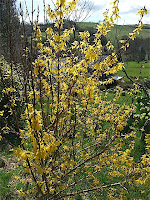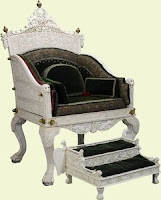
...we were in England, and it was April, but the weather gods apparently were still locked into darkest February. Far from the April that Robert Browning longed for in his Home Thoughts from Abroad, we found London to be, as Maggie Smith says in Gosford Park, "positively glay-see-ul".
Muffled into woolly hats and scarves, we shivered our way over to the Tate Modern to see an excellent Arshile Gorky retrospective, ducked into the beautiful, historic Southwark Cathedral, and scampered briskly through Borough Market, where the most popular stall seemed to be this gent, selling hot, spiced mulled wine.

What a difference a few days can make, though. On Easter Sunday morning, as we boarded the Great Western Train to South Devon, the skies cleared, the arctic blasts blew somewhere else, and as we rattled our way south-west, we caught glimpses through the train window of a real spring landscape . By the time we arrived at Totnes, and drove to our dear friend Jill's home, the next lines of Browning's poem took flight:

And whoever wakes in England
Sees, some morning, unaware,
That the lowest boughs and the brushwood sheaf
Round the elm-tree bole are in tiny leaf,
While the chaffinch sings on the orchard bough
In England - now!
Sees, some morning, unaware,
That the lowest boughs and the brushwood sheaf
Round the elm-tree bole are in tiny leaf,
While the chaffinch sings on the orchard bough
In England - now!

It wasn't just the tiny leaves that were peeping through, or the songbirds going about their busy meetings and greetings, it was the clouds of daffodils, the banks of primroses -- both those in Jill's garden, and those growing wild along the hedgerows.



And there, in the neighbor's garden, the forsythia gleamed golden, and the delicate hellebore shyly said hello.
 Bordered on one side by Dartmoor, with its bare landscape, its bogs and echoes of The Hounds of the Baskervilles, and on the other side by the English Channel, this small part of South Devon has a particularly soft feel to it. The rolling green hills dip in and out of sheltered valleys that house cottages, organic farms (including Riverford Farm with its CSA vegetable boxes and its delicious Field Kitchen dining commons), small villages and towns...
Bordered on one side by Dartmoor, with its bare landscape, its bogs and echoes of The Hounds of the Baskervilles, and on the other side by the English Channel, this small part of South Devon has a particularly soft feel to it. The rolling green hills dip in and out of sheltered valleys that house cottages, organic farms (including Riverford Farm with its CSA vegetable boxes and its delicious Field Kitchen dining commons), small villages and towns...
...pubs that date back to Saxon times...

...and many curious sheep.
 And, as can happen anywhere in Britain, it was in one of these small towns that we had one of those "there'll always be an England" moment. A Landrover, parked with a faulty handbrake, had rolled back into the street, blocking the narrow roadway.
And, as can happen anywhere in Britain, it was in one of these small towns that we had one of those "there'll always be an England" moment. A Landrover, parked with a faulty handbrake, had rolled back into the street, blocking the narrow roadway.There was no sign of the owner, and as cars and vans stacked up one behind the other for over half an hour, there was only one, tentative, honk of a horn. We speculated on the cacophony of sound that would be bursting forth in either Paris or Rome under the same situation! Here, people sat quietly in their cars, patiently waiting, or walked up to see what was what, exchanging polite smiles with one another.

Eventually, a group of burly young and old blokes came up, and with a big heave-ho, they bumped and shouldered the offending vehicle over to the side.

An idyllic couple of days later, we took the train back to London, where the glories of spring blossoms were now also in full view.
On a beautiful sunny morning, we made our way to the "other" Tate, the Tate Britain, the original Tate, where a big exhibition of Chris Ofili's paintings takes up seven rooms. Born in Manchester in 1968, Ofili's early fame and notoriety came with his use of elephant dung balls, which he applied to the canvases and used to prop the paintings on the floor. He told an interviewer once that he felt this gave the paintings a feeling that they'd come from the earth, rather than just being hung on a wall.

At first glance, the dung balls are quite startling, but they quickly recede as you take in the richly layered paintings, all of them bursting with energy and color. Ofili also adds glitter, resin, map pins, and collaged magazine cut-outs. The result is like a big personal, cultural and spiritual narrative that keeps you standing in front of each painting for a long time, following the various story lines.
Ofili now lives in Trinidad and his most recent works reflect the landscapes, customs and beliefs of his new home. No more elephant dung, but still a vivid representation of some kind of paradise.
 In sharp contrast to the art of contemporary British artists, the Queen's Gallery at Buckingham Palace is currently showing paintings, sculptures and furniture bought by Queen Victoria and Prince Albert during their life together. Victoria & Albert: Art & Love, doesn't just share Victoria and Albert's love and enthusiasm for art, it also presents an extraordinary portrait of 19th century England at the very peak of its global power. The era when the sun never set on the English Empire and when most of the countries in an atlas were colored pink for England!
In sharp contrast to the art of contemporary British artists, the Queen's Gallery at Buckingham Palace is currently showing paintings, sculptures and furniture bought by Queen Victoria and Prince Albert during their life together. Victoria & Albert: Art & Love, doesn't just share Victoria and Albert's love and enthusiasm for art, it also presents an extraordinary portrait of 19th century England at the very peak of its global power. The era when the sun never set on the English Empire and when most of the countries in an atlas were colored pink for England!
Among the many glittering colonial treasures was this Indian sapphire and diamond brooch, given to Victoria by Albert on the eve of their wedding, which she wore constantly.

This spectacular throne became the centerpiece of the Indian Pavilion in the 1851 Great Exhibition, where it was presented to Victoria. The densely carved Indian elephant ivory piece tells its own narrative stories through Indian and European motifs and is decorated with gold, diamonds, emeralds, rubies, and embroidered silk.
 The Great Exhibition, which was the brainchild of Albert, featured the "Works of Industry of All Nations". On a raised dais in the central crossing of the Crystal Palace, built in Hyde Park and enclosing several of the park’s mature trees, the Queen (in this Eugene Lami watercolor) received the report of the Commissioners, led by Prince Albert. The Queen described the day as ‘one of the greatest and most glorious days of our lives’.
The Great Exhibition, which was the brainchild of Albert, featured the "Works of Industry of All Nations". On a raised dais in the central crossing of the Crystal Palace, built in Hyde Park and enclosing several of the park’s mature trees, the Queen (in this Eugene Lami watercolor) received the report of the Commissioners, led by Prince Albert. The Queen described the day as ‘one of the greatest and most glorious days of our lives’.
You could say that the real legacy from this period of English history is represented by the Albert Memorial in Kensington Gardens, commissioned by Victoria to honor her beloved Albert after he died from typhoid fever in 1861.
Opened in 1872, with the statue of Albert ceremonially "seated" in 1875, the memorial consists of an ornate canopy or pavilion containing a statue of Prince Albert facing south. The memorial is 176 feet tall, took over ten years to complete, and cost £120,000.
Emerging into the warm late afternoon sunlight, and completely absorbed and transported by all this history, I was ready to burst out into a hearty rendition of Rule Brittania. Fortunately, the sober realities of the results of that "glorious" Empire era took control, and as we walked past Buckingham Palace and into Green Park, I contented myself with a quiet God Save the Queen!
À bientôt!

Love the new blog!!! Spring is here and my daffodils are out as I am sure you witnessed - apologies for untidy house!!!! Your pictures are amazing was lovely to see you all over Easter xx
ReplyDelete